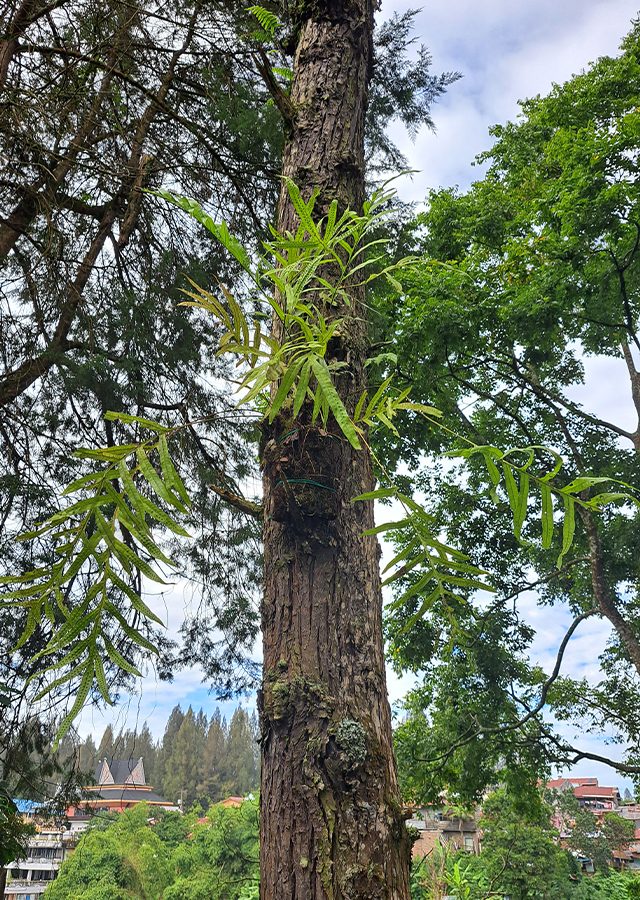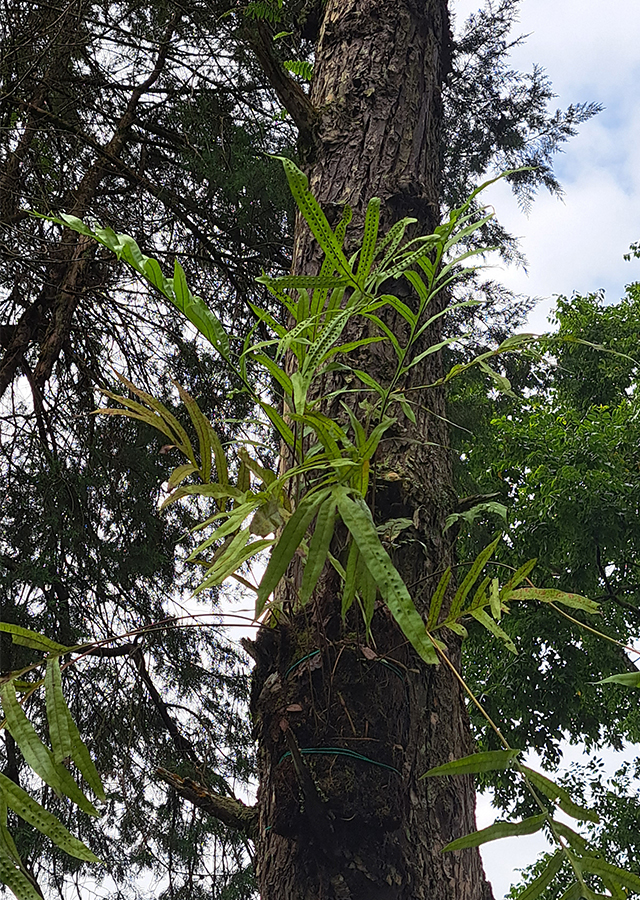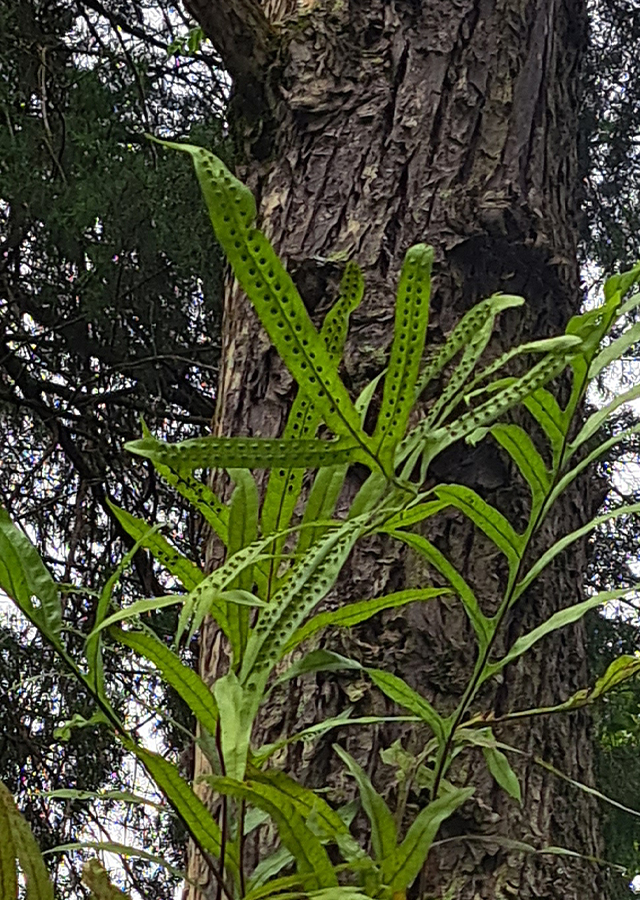Traditional Herbs from Phymatosorus scolopendria
relieve_nasal mucous membrane inflammation
- Take enough fresh fragrant fern.
- Heat it over a fire.
- Inhale the smoke\u00a0to relieve nasal mucous membrane inflammation.
ulcers
- Take fresh fragrant fern to taste.
- Grind it until it becomes a paste.
- Put the leaf paste on the boil.
What is Phymatosorus scolopendria Looks like??



Parts of Phymatosorus scolopendria that could be used
- Leaves
- Roots
- Rhizomes
Phymatosorus scolopendria Distribution
Phymatosorus scolopendria is spread from Australia, throughout Polynesia, Asia to Madagascar and Africa. This species can be found throughout the Malesia region. In Indonesia, P. scolopendria can be found in Sumatra, Kalimantan, Java, the Lesser Sunda Islands, Sulawesi, Maluku, and Irian Jaya. In various countries, P. scolopendria has been widely used as an ornamental plant. The uniqueness of its leaves, its shape which produces leaves on rhizomes that are quite closely spaced, as well as its resistance to dry conditions, gives it its own charm and is suitable for planting as an architectural (outdoor) ornamental plant. P. scolopendria leaves are known to have potential as a raw material for cosmetics in the perfume industry. In Malaysia and Hawaii, this species is used as a clothes freshener and as a fragrance in coconut oil. Apart from that, P. scolopendria also has benefits as a medicinal plant which is used as an ingredient in traditional medicine in several countries.Agroecology of Phymatosorus scolopendria
P. scolopendria has the ability to live epiphytically, terrestrially and lithophytically. Epiphytically, this species generally lives on old trees in open areas and oil palm trunks in plantations. Also found living in primary rainforests, agricultural land, secondary rainforests, coastal forests, disturbed areas, coastlines (coastal cliffs, rocky beaches). Terrestrially it is found living in the soil at the edge of ponds, root gaps, flat ground. However, this species rarely lives on the ground. More often found in leaf litter and mossy rocks or at the base of branches of trees or shrubs high above the ground. Sometimes this species is also found growing in open areas on the outskirts of forests and can live in the lowlands at sea level up to an altitude of 2,100 m above sea level. This species is tolerant of short-term drought, but will do better if planted in consistently moist conditions. This species is easy to cultivate and also has a wide tolerance to various habitat types and altitudes.
Morphology of Phymatosorus scolopendria
- Rhizome creeping, wide, 7-8 cm thick, terete, waxy white, internode 1-9 cm, roots sparse to dense. Rhizome scales shield, sometimes pseudo shield, sparse to dense, close to stretched, oval or triangular, margins on basal torn, rembang pointed.
- Leaves one or two forms, single or pinnate, pinnate leaves, stemmed, green shiny, the edges of the leaves are flat-slightly wavy, the tips of the leaves are tapered (acuminate). The leaves are pinnate, the stem is about 5-5-cm long with a thickness of 0.8-7.0 mm, the leaves are elliptical to oval in outline, at their widest. bottom to middle, lobes 1-10 on each side, longest lobe in position 1-2 from the basal, upper lobe at an angle of 35-50 to the lobe, the lobe is longer than basal upper lateral lobes. The leaf veins are more or less submerged and not obvious or obvious, more or less straight or curved, branching in two near the edge or middle or each central bony areola forms two lateral veins, forming several rows of equal sized areolae or one row. striking. The veins in it are more or less submerged or inconspicuous, sometimes more striking, variegated, forming a dense mesh with smaller areopas, single free leaf veins or forming a single fork. The sori are very large, separate, round or elliptical, orange-brown in color, deep-set, scattered on the abaxial surface of the leaf, appear as protrusions on the upper surface (adaxial), 1-3 rows between the central spine and the periphery, one sori inside, or only outside, in each areola of the main central bone, on the entire surface of the leaf sheet or on the basal part is absent.
Cultivation of Phymatosorus scolopendria
- Plant propagation can be done with sori or pieces of rhizome.
- Propagation with spores is done by spreading the spores on a disinfected medium and storing them in a relatively damp place. The sporophytes are transplanted in groups when they are 1 cm high and transplanted again in batches. separately when they reach a height of more than 3 cm. Meanwhile, propagation via rhizome pieces must be planted at a depth of no more than 5 cm in well-drained soil or attached. on fern root boards. Next, the plant must be kept in light shade and a warm place.
- Germination\u00a0P generally begins with the formation of a heart-shaped prothallus, gametophyte phase, generally lobed leaves." In general, P. scolopendria grown from spores can be harvested for leaves after 2-3 years, whereas if grown from rhizomes, harvesting may be done when the plant is 6 years old. months after planting.
Phymatosorus scolopendria, more details :
Chemical Content of Phymatosorus scolopendriaGlycyrrhizin, saponin, coumarin, ecdysone, 20-hydroxyecdysone, makisterone A and C, inocosterone, amasterone A, small amounts of poststerone and 24,28-diepi-cyasterone.
Benefits of Phymatosorus scolopendria
Treats boils, wounds, abscesses, chronic diarrhea, laxatives, filariasis in babies, headaches, body aches, stomach aches, stomach ulcers, arthritis, massage oil to induce postpartum discharge (postpartum tonic), breast swelling associated with breastfeeding , postpartum depression, relieve catarrh.
Simplisia of Phymatosorus scolopendria
Another Facts for Phymatosorus scolopendria :
Synonym of Phymatosorus scolopendriaPhymatodes scolopendria (Burm.f) Ching, Microsorum scolopendria (Burm.f.) Copel., Polypodium scolopendria Burm.f.
Habitus of Phymatosorus scolopendria
Fern. Ferns, epiphytes, lithophytes, creeping plants, annuals (perennials)
Habitat of Phymatosorus scolopendria
- Forest
- Coast
- Rocky Area
No comments:
Post a Comment